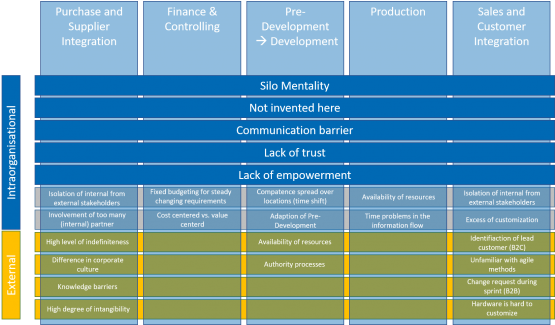15. June 2018
Master the complexity of product development with agile development methods
The development of physical products is changing rapidly in response to increasing innovation, time and cost pressures. Agile development methods and process models are already widely used and daily practice in software development. Now the usage increases in the development departments of the manufacturing industry. Many companies, however, still face great challenges as to how an (industry-) specific adaptation of “agile” procedures to the special characteristics of hardware development in their own company can be performed: Which development projects are suitable for the agile approach and which methods, elements and tools are effective? Our INC Invention Center members dealt with these questions within a R&D project under the direction of Stephan Schröder from Fraunhofer Institute for Production Technology IPT in Aachen and provide exciting insights.
Success in agile development: The right methods, elements and tools are crucial
Compared to traditional development approaches, the use of agile methods offers great advantages in hardware development, especially in the early project phases. It has been shown, however, that generally valid solution concepts for hardware development hardly exist and only seem to be useful to a limited extent. Rather, the successful implementation of agile development requires selecting and adapting the right methods, elements and tools according to the company’s own needs and framework. Furthermore, the question arises for which kind of development projects the agile approach can be useful.
General conditions and project characteristics for a successful use of agile methods
The INC Invention Center members evaluated 16 criteria regarding their suitability for the identification of projects for which an agile approach is appropriate. With the help of priority, the long list was finally reduced to a shortlist of seven criteria in order to achieve greater practicability of the project evaluation. The seven most important criteria and the prioritization carried out are shown in Figure 1.
Often underestimated: Interface problems cause implementation barriers.
The inadequately managed interfaces between agile development projects and other company departments and stakeholders often lead to implementation barriers. The large number of existing problems was structured within the INC project by using a framework (cf. Figure 2). The study identified two major problems. On the one hand, the design of interfaces to external development partners and other stakeholders (e.g. public authorities) and, on the other hand, the cultural discrepancies between agile and non-agile teams and departments (both internally and externally).
By the way: The motto of this year’s Technology and Innovation Management Conference on October 25-26 is “Agile Invention – Hype or Game Changer?”.
Be there and discuss with us – we look forward to meeting you!




